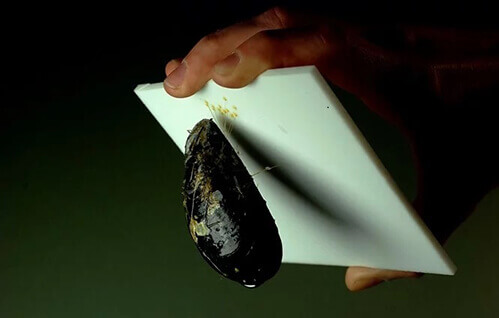WEST LAFAYETTE, Ind. – A novel underwater adhesive technology, based on a glue used naturally by marine creatures, soon may provide a safer adhesive option for industries ranging from biomedical to aerospace.
Mussel Polymers Inc. (MPI) – a startup created by Wardenclyffe Chemicals Inc., a technology development company – has licensed this patented adhesive technology from the Purdue Research Foundation. The technology was created by Jonathan Wilker, a Purdue professor of chemistry and materials engineering, with students in his laboratory.
 Photo Caption: A mussel holds onto a Teflon sheet by a tiny strand. Mussel Polymers Inc. (MPI) - a startup created by Wardenclyffe Chemicals Inc., a technology development company - is ready to take sea-inspired adhesives from Purdue to market. (Image provided)
Photo Caption: A mussel holds onto a Teflon sheet by a tiny strand. Mussel Polymers Inc. (MPI) - a startup created by Wardenclyffe Chemicals Inc., a technology development company - is ready to take sea-inspired adhesives from Purdue to market. (Image provided) The adhesive is called poly(catechol-styrene), or PCS. It was engineered to mimic the glue that mussels naturally use to attach to substrates in the ocean, and represents the first new adhesive chemistry to reach the market in decades.
The research effort that led to the development of PCS lasted over a decade and was supported with $2 million from the Office of Naval Research.
"We have been studying sea creatures, how they stick, and designing synthetic mimics of these materials," Wilker said. "Now we are quite excited to move these new materials from the research lab into the marketplace. There is potential here to impact several industries, including products that people use in their daily lives."
The team behind Mussel Polymers Inc. licensed the technology through the Purdue Research Foundation's Office of Technology Commercialization






